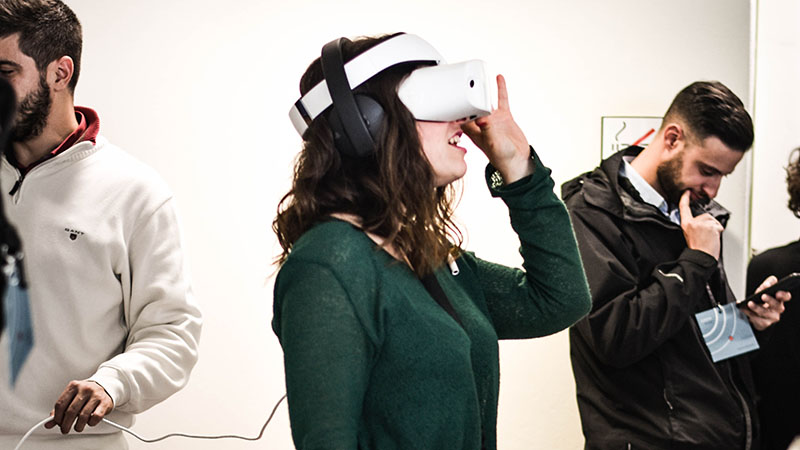VR is reshaping the way companies approach staff training.
Workplace training has always been difficult for most companies for a number of reasons, geographic boundaries, safety concerns, and complex training scenarios. These inadequacies have left training incomplete in many circumstances. VR(virtual Reality) is changing the training landscape and filling in the gaps.
The argument for VR in corporate training is simple – it can increase engagement and knowledge retention levels, and employees can be trained in a safer, more cost efficient way. VR enables employees to learn through practical experience. Experiential learning has long been viewed as the most effective way to learn and studies have shown that learning through experience increases the quality of learning, and retention by 75-90%.
In most cases, companies use VR to allow their employees to practice dealing with real-world scenarios. Here are some other advantages of using VR in training:
- Immersive experiences: Engagement is critical to training outcomes, and the immersive training environment provided by VR boosts engagement.
- Practice makes perfect: Workers with difficult jobs can sharpen their skills without worrying about real-world consequences.
- Reduced pressure and enhanced creativity: Because all training is virtual, workers can take risks they usually wouldn’t take or pursue creative, high-risk solutions to problems.
- Previewing: VR technology allows companies to perform test runs of new initiatives to see how employees respond.
- Accelerated learning: Because VR is so immersive and compelling, learners absorb information faster and retain what they have learned longer. Memory formation is linked to emotional response, and VR is an emotionally charged experience.
How are companies using these technologies in their employee training? Companies all around the world are quickly taking advantage of this technology. Let’s look at some case studies.
How is ExxonMobil Using VR for training?
Exxonmobil has invested heavily inVR in their training program. It has been under development for some time, so chalk up ExxonMobil’s virtual reality training initiative to serendipity. The effort is coming to full maturity in the middle of a pandemic, when remote learning is both necessary and encouraged.
As many as 18 VR-based modules in various stages of development will soon enable ExxonMobil to train workers remotely for its new $500 million polypropylene plant in Baton Rouge. The modules will immerse operators in a computer-generated environment to perform critical tasks, and will simulate a physical presence in a nonphysical world to guide them through various scenarios.
ExxonMobil is using VR for safety training. Users can put on a helmet and headphones, grab a controller, and plug into the virtual world, engaging multiple senses. They can turn their heads, walk around and watch the VR world react. And long after the game is over, the skills learned will remain relevant. For oil and gas operators, practice in a digital garage simulation is more than a game – it’s a lesson.
Immersive simulations can transport VR users onto the loading dock of a liquefied natural gas (LNG) tanker, where they spend a day on the job assessing and reacting to different scenarios, from the mundane to the complex. The experiences allow employees to hone their instincts, catch their mistakes, and make instant decisions so that they’re better equipped to work smarter and safer
How UPS Uses VR For Employee Training?
UPS has announced the expansion of its driver training to include virtual reality (VR) headsets at its UPS Integrad training facilities in Cologne, Germany, and Burton upon Trent, UK. The VR headsets simulate the experience of driving on German and UK city streets while teaching a more memorable classroom lesson.
Virtual reality allows for real-world experiences without danger to employees and the general public. This type of training is especially helpful for logistics companies like UPS, where workers are in fast-paced settings inside the hub and out on the road, behind the wheel.
The brown trucks seen crisscrossing neighborhoods throughout the country are the most visible, well-known members of the UPS fleet. While drivers are taught safety measures on the road, a good bit of their training is now taking place inside a headset.
“The headsets for UPS drivers in Cologne and Burton upon Trent use images of local streets to identify typical local road hazards,” said Thomas Scholz, manager of UPS Integrad in Cologne.
Walmart use VR to train their employees
Since 2017, the retail giant has used VR applications to train and assess the skills of their employees. The applications incorporate 360° video taken from within one of their stores and interactive experiences that challenge the employee to solve interpersonal conflicts unfolding in front of them. Managers can see how an employee might deal with a difficult customer without the need of any real-life drama.
Much of the application’s utility is to step into real-life scenarios as an employee, but in one instance, the employee is forced into an alternate perspective. In one moment, they are a cashier with a long line of customers in front of them. Then, they suddenly find themselves as one of the customers reading a text from their spouse asking when they’ll be home. This profound facet of the experience is a testament to the depth of what can be expressed through VR training.
Walmart is distributing 17,000 headsets to 5,000 locations that will reach a million employees.
The future is now
A 2020 PwC study suggested that at scale, VR can be significantly more cost effective than traditional soft skills training options, finding that employees completed VR programs up to four times faster than in-person trainings, and 1.5 times faster than e-learning programs — in large part because the immersive experience made it easier for learners to stay focused.
The study also found that employees who completed VR training felt almost four times more emotionally connected to the content than classroom learners did, and more than twice as connected as e-learners, illustrating the huge impact that VR can make.
With the increasing number of companies offering VR training to their employees and the burgeoning advancements in VR technology, there is no better time than the present to see what this exciting new medium can do for your company.




